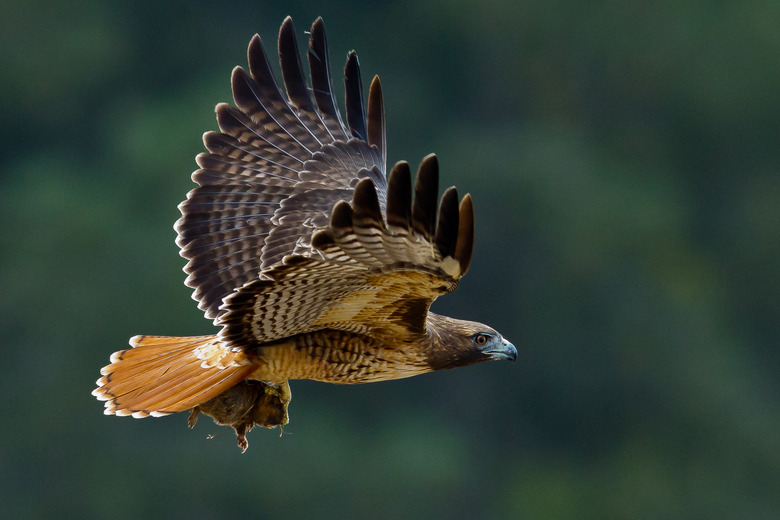The Life Cycle Of The Red-Tailed Hawk
Hawks belong to the category of birds known as raptors (birds of prey). Birds of prey have been revered and despised since the beginning of time. Falconry (a hunting sport using raptors as aides) began in Asia and Egypt in 3,000 B.C. and continues today. Humans destroyed large hawk populations because young hawks preyed on small domestic animals like chickens.
Mating and Nesting
Mating and Nesting
Hawk breeding season lasts from March through May. Mating begins in early March with both males and females performing aerial displays. According to the educational resource website Rain Network, mating hawks are seen "circling and soaring to great heights, they fold their wings and plummet to treetop level, repeating this display as much as five or six times." Hawks tend for bond for life.
Nest building starts after the mating displays. Located 35 to 75 feet off the ground, they build the nests in the forks of large trees and sometimes on telephone poles. Nests are large, flat and shallow. The preferred building material is 1/2 diameter sticks and twigs. Males and females work on the nests and use them from year to year while performing required repairs.
Eggs
Eggs
The Rain Network website also points out that "The female usually lays two dull-white to bluish-white eggs that are marked with a variety of irregular reddish spots and splotches." Females then handle most of the four-week incubation period. While the female sits on the nest, the male must hunt for both of them and brings her food to the nest.
Young
Young
The hawks hatch blind and covered in white down. They remain in the nest for 44 to 48 days before fledging, or learning to fly. Hatchlings grow very slowly and require a lot of food. Both parents share the hunting required to help the new babies grow. During the last 10 days before fledging, the hatchlings are nearly as large as adult birds and spend time flapping their wings and balancing on the edge of the nest, waiting to fly into the air.
Juvenile
Juvenile
It takes hawks between 18 months and three years to reach sexual maturity. They spend this time learning how to hunt. Because of their inexperience, juvenile hawks often eat road-killed animals. In the U.S., the red-tail got the name chicken hawk because young hawks often catch the domesticated birds. Before modern regulations, chicken-owners killed hawks indiscriminately, and by the evidence of dead birds hanging from power lines and fences, some still do.
Adult
Adult
The adult red-tail hawk can live between 13 and 25 years. Adult hawks range from 19 to 25 inches long and can have a wingspan of nearly 56 inches. Their rich, russet-red tail gives red-tail hawks their name. According to the website of the Lee Richardson Zoo in Garden City, Kansas, "The most common color form has a white breast with a dark band of feathers on the belly. Their eyes are amber colored." The predatory hawks also sport large, sharp, curved talons and beaks. Around 85 to 90 percent of the adult red-tail's diet is prey made of small rodents, though sometimes they will eat another bird or perhaps a snake.
Cite This Article
MLA
Griffin, Dana. "The Life Cycle Of The Red-Tailed Hawk" sciencing.com, https://www.sciencing.com/life-cycle-redtailed-hawk-6540201/. 22 November 2019.
APA
Griffin, Dana. (2019, November 22). The Life Cycle Of The Red-Tailed Hawk. sciencing.com. Retrieved from https://www.sciencing.com/life-cycle-redtailed-hawk-6540201/
Chicago
Griffin, Dana. The Life Cycle Of The Red-Tailed Hawk last modified March 24, 2022. https://www.sciencing.com/life-cycle-redtailed-hawk-6540201/
